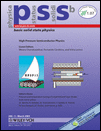High pressure Raman study of carotene-encapsulating single-wall carbon nanotubes
Abstract
The pressure response of carotene-encapsulating single-wall carbon nanotubes is investigated by means of Raman spectroscopy. The pressure evolution of the tangential G band frequencies of the carbon nanotubes is linear without any specific features. On the other hand, the pressure response of the carotene's ν1 mode frequency is quite distinct, having a smaller low pressure slope than that reported in the literature for the molecule. This behaviour is compatible with the pressure screening effect in the interior of carbon nanotubes. For pressure higher than 2 GPa, the pressure slope becomes even smaller, an effect which can be attributed to the theoretically predicted cross-section deformation of the encapsulating tubes. (© 2009 WILEY-VCH Verlag GmbH & Co. KGaA, Weinheim)




